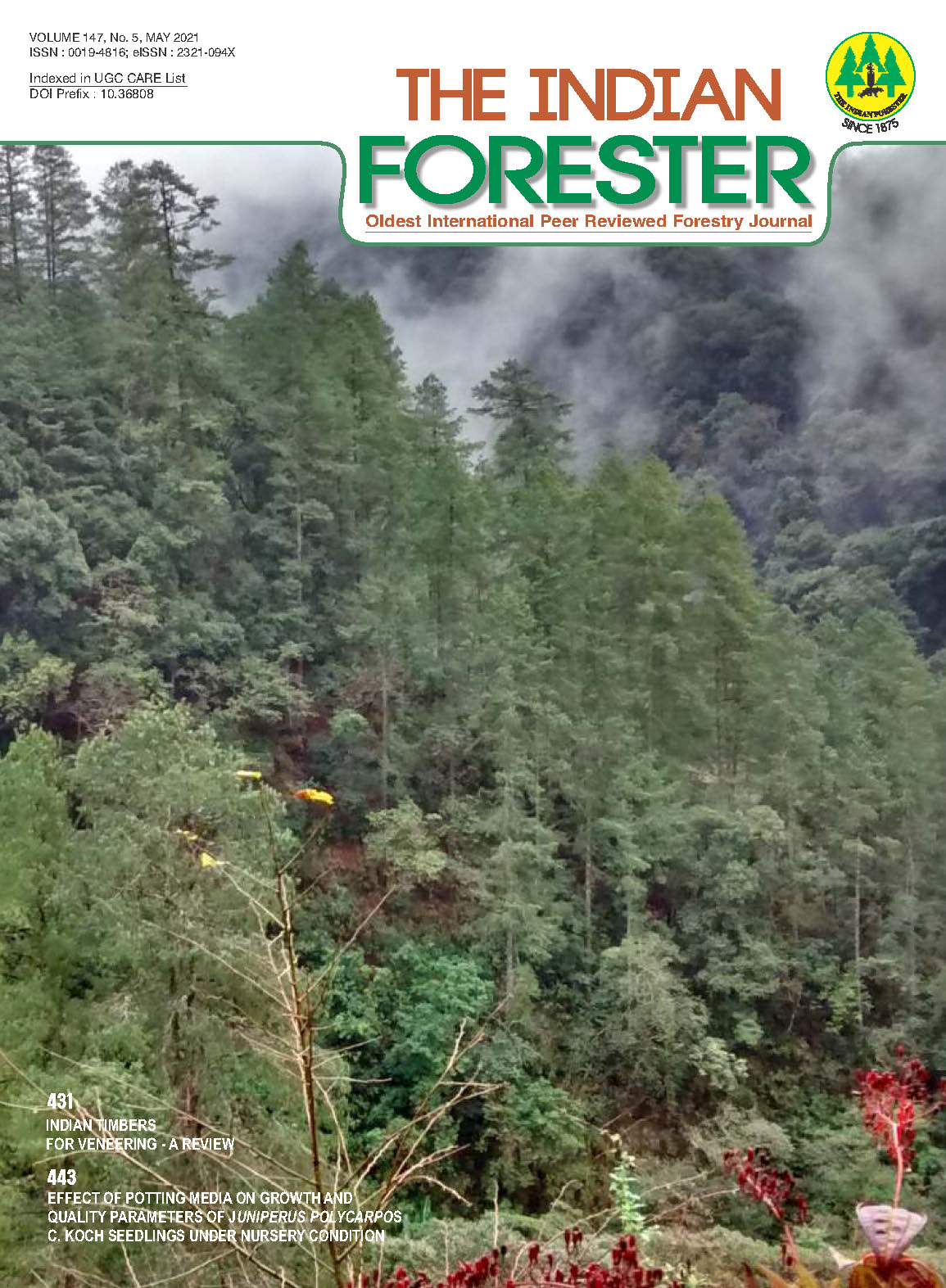Floristic Diversity along Altitudinal Gradient in Shopian Forest Range of J. & K., India
DOI:
https://doi.org/10.36808/if/2021/v147i5/152796Keywords:
Altitude, Management, Species, Sampling, Regeneration, Silviculture.Abstract
The present study was carried out in the Shopian Forest Range in Kashmir Valley of Jammu and Kashmir, Union Territory of India. The study area was divided into three altitudinal gradients (1800m-2100m; 2100-2400m; 2400- 2700m) and stratified random sampling technique was used to study the community composition and phyto-sociological parameters of the vegetation. A total of 53 plant species belonging to 35 families were reported including 09 trees, 08 shrubs and 36 herbs. Poaceae was the dominant family represented by seven species, followed by Pinaceae, Rosaceae and Fabaceae with four species each. The presence of six trees, seven shrub and twenty eight herb species were found in the lower altitude with Pinus wallichiana as dominant tree species. The mid altitude had species richness of 07 tree species, 06 shrub and 25 herb species. The Shannon diversity index showed a decreasing trend from lower altitude to higher one in all three life forms. The distribution and species richness pattern of different species are affected by various locality factors and can be used for managerial aspects. Hence the present study can form a baseline for implementing management aspects for conservation, regeneration strategies and application of silvicultural systems at different altitudes and species wise.References
Korner C. (1998). A reassessment of high elevation treeline positions and their explanation. Oecologia, 115 (8): 445-459.
Loreau M., Naeem S., Inchausti P., Bengtsson J., Grime J.P., Hector A., Hooper D.U., Huston M. A., Raffaelli D., Schmid B., Tilman D. and Wardle D.A. (2001). Biodiversity and ecosystem functioning: current knowledge and future challenges. Science, 294: 804-808.
Mahumuza M. and Byarubaba D. (2009). Impact of land use on the ecology of uncultivated plant species in the Rwenzori Mountain range, Mid Western Uganda. African Journal of Ecology, 47 (4): 614-621.
Margalef R. (1968). Perspectives in ecological theory. University of Chicago Press, Chicagopp. 11-111.
Negi B. S., Chauhan D. S. and Todaria N. P. (2008). Inventory of species richness of panchayat and adjoining reserve forests in three districts of Garhwal Himalaya, India. Tropical Ecology, 49(2): 121-129.
Pala N.A., Mathur M., Iqbal K., Negi A.K., Shukla G. and Chakravarty S. (2017). Community dynamics: Competition and facilitation studies of tree species in temperate forests of the Indian Himalaya. Indian Journal of Ecology, 44 (2): 279-288.
Pala N.A., Negi A.K. and Todaria N.P. (2015). Ecological status and socio-cultural significance of Sem Mukhem temple landscape in Garhwal Himalaya, India. Indian Forester, 141(5): 496-504.
Pala N.A., Negi A.K., Gokhale Y. and Todaria N.P. (2013). Tree Regeneration status of sacred and protected landscapes in Garhwal Himalaya, India. Journal of Sustainable forestry, 32: 230-246.
Pala N.A., Negi A.K and Todaria N.P. (2015). Ecological status and socio-cultural significance of semmukhem temple landscape in Garhwal Himalaya, India. Indian Forester, 141(5): 496-504.
Pandey K.P., Adhikari Y.P. and Weber M. (2016). Structure, composition and diversity of forest along the altitudinal gradient in the Himalayas, Nepal. Applied Ecology and Environmental Research, 14(2): 235-251.
Philips E.A. (1959). Methods of vegetation study. A HoltDryden book, Henry Holt and Co. Inc. New York.
Rawal R.S. and Dhar U. (1997). Sensitivity of timberline flora in Kumaun Himalaya, India: Conservation. Arctic and Alpine Research, 29 (1): 112-121.
Shaforth P., Stromberg J.C. and Patten D.T. (2002). Riparian Vegetation Response to Altered Disturbances and Stress Regimes. Ecological Applications, 12(1): 107-123.
Shank R.E. and Noorie E.N. (1950). Microclimate vegetation in a small valley in eastern Tennessee. Ecology, 11: 531-539.
Sharma C.M., Ghildiyal S.K., Gairola S. and Suyal S. (2009).
Vegetation structure, composition and diversity in relation to the soil characteristics of temperate mixed broad-leaved forest along an altitudinal gradient in Garhwal Himalaya. Indian journal of science and Technology, 2: 39-45.
Sharma P., Rana J.C., Devi U., Randhawa S.S. and Kumar R. (2014). Floristic diversity and distribution pattern of plant communities along altitudinal gradient in Sangla valley, Northwest Himalaya. The Scientific World Journal, 14: 1-11.
Siddiqui M.F., Arsalan A.M., Hussain M.I., Iqbal J. and Wahab M. (2013). Present state and future trends of pine forests of MalamJabba, swat district, Pakistan. Pakistan Journal of Botany, 47(6): 2161-2169.
Simpson E. H. (1949). Measurement of diversity. Nature, 163: 688-688.
Singh K.N. and Kaushal R. (2006). Diversity and quantitative analysis of dominant tree species in district Chamba of Himachal Pradesh. Indian Journal of Forestry, 29(3): 254251.
Suresh R. (2006). Soil and water conservation engineering. Standard publisher, Delhi India.
Tansley A.G. (1920). The classification of vegetation and the concept of development. Journal of Ecology, 8(1): 114.
Verma R.K. and Kapoor S.K. (2011). Plant species diversity in Ropa-Giavung valley in cold deserts of district Kinnaur, Himachal Pradesh. Biological Forum, 3(2): 34-43.
Verma R.K. (2016). Status of plant diversity along an altitudinal gradient in Dankund beat of Kalatop Khajjiar wild life sanctuary of district Chamba, Himachal Pradesh. Biological Forum, 8(1): 540-547.
Whittaker R.H. (1972). Evolution and measurement of species diversity. Taxon., 21(2/3): 213-251.
Wiafe E.D. (2014). Patterns of tropical tree species richness along elevational gradients of mountain Afadjato, Ghana. Eurasian Journal of Forest Science, 2(2): 18-23.
Downloads
Downloads
Published
How to Cite
Issue
Section
License
Unless otherwise stated, copyright or similar rights in all materials presented on the site, including graphical images, are owned by Indian Forester.





